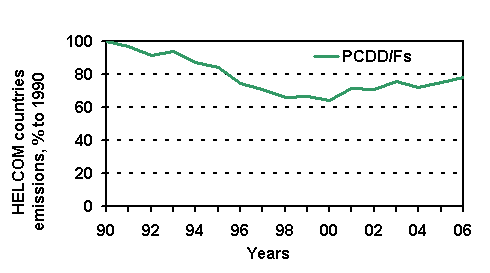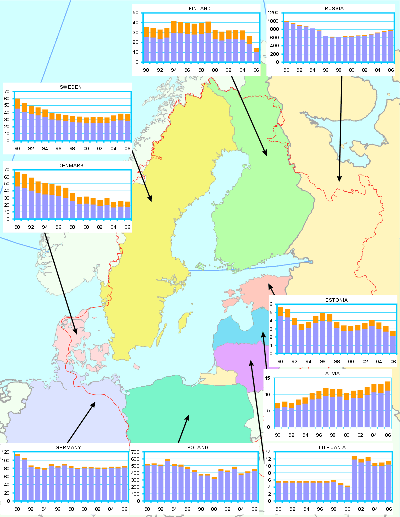Atmospheric emissions of PCDD/Fs in the Baltic Sea region
|
||||
Key message
![]() Annual emissions of dioxins and furans in HELCOM countries have decreased during the period from 1990 to 2006 by 22%.
Annual emissions of dioxins and furans in HELCOM countries have decreased during the period from 1990 to 2006 by 22%.
Results and Assessment
Relevance of the indicator for describing the developments in the environment
This indicator shows the levels and trends in emissions of dioxins and furans from anthropogenic sources of HELCOM countries to the atmosphere. These emissions represent the pressure of emission sources on the atmosphere of the Baltic Sea region and subsequently on the Baltic Sea aquatic environment.
Policy relevance and policy reference
HELCOM adopted a Recommendation in May 2001 for the cessation of hazardous substance discharges/emissions by 2020, with the ultimate aim of achieving concentrations in the environment near to background values for naturally occurring substances and close to zero for man-made synthetic substances.
On the European level the relevant policy to the control of emissions of PCDD/Fs to the atmosphere is being taken in the framework of UN ECE Convention on Long-Range Transboundary Air Pollution (CLRTAP). The Executive Body of CLRTAP adopted the Protocol on Persistent Organic Pollutants on 24 June 1998 in Aarhus (Denmark). According to one of the basic obligations, Parties to the Convention shall reduce their emissions of PCDD/Fs below their levels in 1990. The Protocols has been signed by 36 and ratified by 28 countries and has been entered into force in 2003.
Assessment
Annual emissions of dioxins and furans have decreased in HELCOM countries during the period from 1990 to 2006 by 22% (Figure 1). The most significant drop of PCDD/F emissions (see Figure 2) can be noted for Denmark (63%), Finland (60%), and Estonia (53%). Some decrease of emission can also be noted for Sweden (37%), Germany (26%), Russia (22%), and Poland (15%).
For some of the HELCOM countries the level of PCDD/F emissions in 2006 is higher than emission of 1990. In particular, Latvia reported higher values of emissions for 2006 in comparison with the emissions for 1990.
In 2006 total annual PCDD/F emissions of HELCOM countries amounted to 1.4 kg TEQ. Among the HELCOM countries the largest contributions to the total annual PCDD/F emission of HELCOM countries belong to Russia (54%) followed by Poland (32%) and Germany (6%).
Maps of the Baltic Sea Region and time-series of annual total PCDD/F emissions of HELCOM countries are shown on Figure 2. The diagrams on the maps also show the fractions of emissions deposited to the Baltic Sea. The highest fractions belong to Denmark and Sweden (about 30%), and the lowest one to Russia (about 1.5%).

Figure 1. Total annual emissions of PCDD/Fs to air from HELCOM countries in period 1990-2006 (% of 1990).
Figure 2: Map of PCDD/F emissions of HELCOM Contracting Parties (CP) to air as totals in tonnes/year for the period 1990-2006. Red sections of the bars identify the fraction of emission deposited to the Baltic Sea. (The emission data of the CP refer to the total area of the CP except for Russian Federation, for which emissions from the territory of Russian Federation within the EMEP domain is used). Click image to enlarge!
Note: different scales have been used for different countries!
Data
Table 1. Total annual PCDD/F emissions from anthropogenic sources of HELCOM countries in period from 1990 to 2006. Values of emissions estimated using interpolation or extrapolation are shown in bold. Units: g TEQ/year
| 1990 | 1991 | 1992 | 1993 | 1994 | 1995 | 1996 | 1997 | 1998 | 1999 | 2000 | 2001 | 2002 | 2003 | 2004 | 2005 | 2006 | |
| Denmark | 66.5 | 64.0 | 58.6 | 53.5 | 50.6 | 49.4 | 47.2 | 44.0 | 36.8 | 31.1 | 31.7 | 29.9 | 27.0 | 29.2 | 23.9 | 26.0 | 24.8 |
| Estonia | 5.7 | 5.4 | 4.3 | 3.6 | 3.8 | 4.5 | 4.9 | 4.8 | 3.8 | 3.4 | 3.4 | 3.5 | 3.7 | 4.1 | 3.7 | 3.3 | 2.7 |
| Finland | 36 | 35 | 33 | 35 | 41 | 41 | 40 | 39 | 40 | 41 | 32 | 31 | 32 | 32 | 32 | 26 | 14 |
| Germany | 114 | 105 | 86 | 82 | 80 | 89 | 85 | 90 | 84 | 80 | 83 | 82 | 81 | 81 | 83 | 83 | 85 |
| Latvia | 7.1 | 7.6 | 7.3 | 8.4 | 9.0 | 10.4 | 10.9 | 11.8 | 11.5 | 11.6 | 10.4 | 11.1 | 11.2 | 12.2 | 13.1 | 13.1 | 13.8 |
| Lithuania | 5.6 | 5.6 | 5.6 | 5.6 | 5.6 | 5.6 | 5.6 | 5.6 | 6.0 | 5.0 | 4.3 | 12.7 | 11.9 | 12.4 | 10.8 | 10.9 | 11.2 |
| Poland | 529 | 535 | 517 | 592 | 520 | 515 | 484 | 440 | 381 | 381 | 333 | 447 | 433 | 482 | 387 | 416 | 449 |
| Russia | 991 | 947 | 901 | 878 | 825 | 769 | 637 | 614 | 606 | 625 | 631 | 643 | 655 | 686 | 716 | 747 | 778 |
| Sweden | 59.8 | 53.3 | 49.9 | 47.0 | 44.0 | 39.6 | 38.3 | 36.6 | 35.0 | 34.4 | 32.8 | 33.5 | 33.7 | 33.0 | 36.1 | 38.3 | 37.5 |
| HELCOM | 1814 | 1758 | 1663 | 1705 | 1579 | 1523 | 1353 | 1285 | 1204 | 1213 | 1162 | 1294 | 1289 | 1372 | 1306 | 1364 | 1416 |
Meta data
Technical information:
1. Source: EMEP/MSC-E, UN ECE Secretariat
2. Description of data: Annual total emissions of dioxins and furans were officially reported to the UN ECE Secretariat by HELCOM countries. These data can be obtained from the EMEP Centre on Emission Inventories and Projections (CEIP) (http://www.emep-emissions.at/ceip/).
3. Geographical coverage: European region
4. Temporal coverage: Data on PCDD/F emissions are available for the period 1990 - 2006. Denmark, Estonia, Finland, Germany, Latvia, Poland, and Sweden presented emission totals for each year in the period 1990-2006. Lithuania and the Russian Federation submitted part of the data for this period. In particular, Lithuania submitted data for 1997-2006. For previous years emission values were obtained using extrapolation. Russia did not report the information on emission for 2001, and 2003- 2006. Value of emission for 2001 was obtained using interpolation between emissions for 2000 and 2002. Emissions of Russia for 2003-2006 were estimated using interpolation between emission for 2002 and the forecast of emission for 2010.
5. Methodology and frequency of data collection: National data on PCDD/F emissions are annually submitted by countries Parties to CLRTAP Convention to the UN ECE Secretariat. The methodology is based on combination of emission measurements and emission estimates based on activity data and emission factors. Submitted data are processed using quality assurance and quality control procedure and stored in the UN ECE/EMEP emission database at EMEP/CEIP Centre.
Quality information:
6. Strength and weakness: Strength: data on emissions are annually submitted, checked and stored in the database
Weakness: gaps in time series of national emissions, uncertainties in national emissions, lack of gridded emissions, and incompleteness
7. Uncertainty: Among the HELCOM countries the level of uncertainty of official data on PCDD/F emission was reported by Finland. From the EMEP countries the information on uncertainties of PCDD/F official emissions is available for Austria, France, and the United Kingdom. The uncertainty of reported data on PCDD/F emissions expressed as percentage relative to mean value of emission is as follows:
Finland: -54% - +76%
Austria: -55% - +120%
France: -55% - +55%
UK: -50% - +200%.
8. Further work required: Further work of national experts on emissions of dioxins and furans is required to fill the gaps in the emission time-series and to reduce their uncertainties.
For reference purposes, please cite this indicator fact sheet as follows:
[Author’s name(s)], [Year]. [Indicator Fact Sheet title]. HELCOM Indicator Fact Sheets 2008. Online. [Date Viewed], http://www.helcom.fi/environment2/ifs/en_GB/cover/.
Last updated: 28.8.2008


